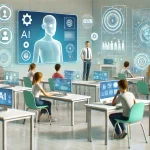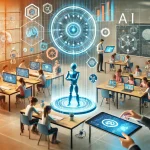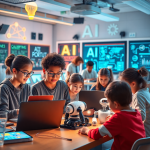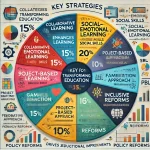Understanding Traditional vs. Innovative Education
Education has evolved significantly over time. Traditional methods, such as lecture-based teaching, rote memorization, and standardized testing, have long been the norm. While these methods provide structure, they often fail to address the diverse needs of modern learners. In contrast, Innovative Education Methods, such as personalized learning, experiential learning, gamification, and project-based education, foster deeper engagement and understanding.
John Dewey, in Experience and Education (1938), championed experiential learning and progressive education, critiquing rigid traditional methods. He argued that learning should build on past experiences (continuity) and engage students meaningfully (interaction). Schools should cultivate critical thinking, problem-solving, and democratic values, with teachers acting as facilitators rather than mere transmitters of information.
Lev Vygotsky’s Sociocultural Learning Theory also emphasizes the importance of social interaction, language, and cultural context in cognitive development. His key principles include:
- Zone of Proximal Development (ZPD): Students learn best when guided within the gap between their independent ability and their potential.
- Scaffolding: Temporary support allows students to progress toward independence.
- Collaborative Learning: Group discussions and peer interactions enhance understanding.
These theories highlight the necessity of shifting from passive to active learning strategies that nurture both intellectual and emotional growth.
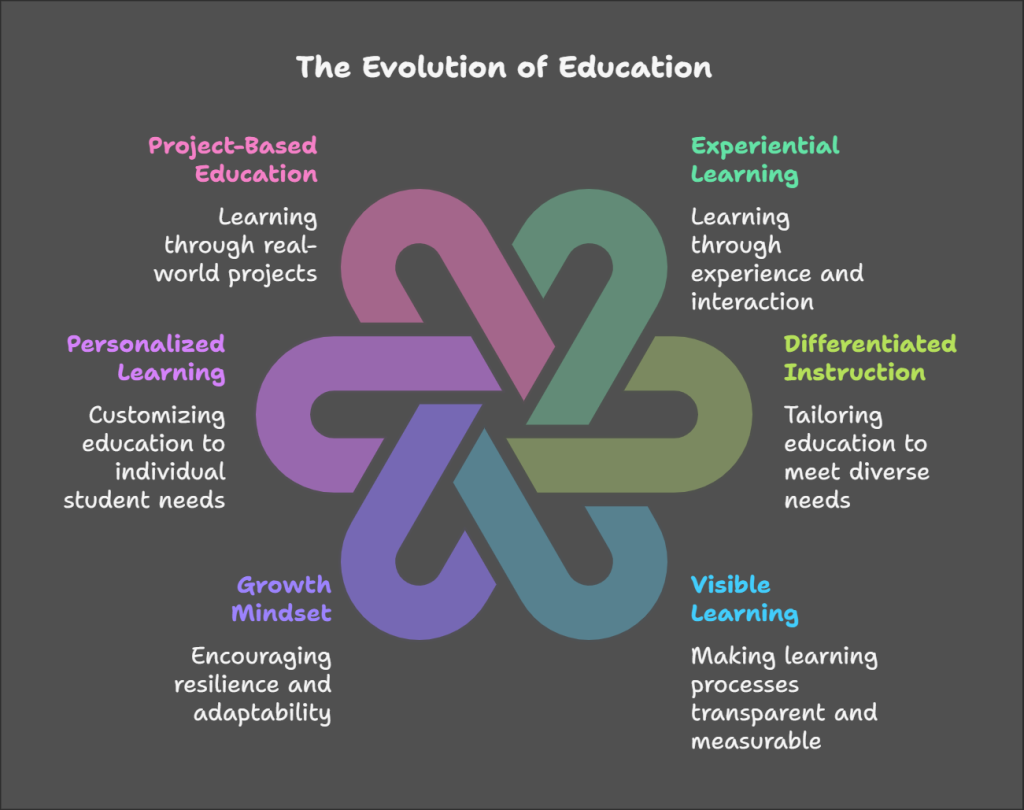
Addressing Student Challenges
Modern education must accommodate diverse learning needs. Common challenges include:
- Learning disabilities (e.g., dyslexia, ADHD)
- Socio-emotional issues (e.g., anxiety, lack of motivation)
- Different learning styles and paces
Differentiated Instruction (Carol Ann Tomlinson)
To meet diverse needs, Tomlinson’s Differentiated Instruction framework suggests:
- Student-Centered Learning: Adapting lessons based on readiness, interests, and learning styles.
- Flexible Teaching: Modifying content, processes, and products to suit different learners.
- Ongoing Assessment: Using continuous feedback to guide instruction.
- Inclusive Classrooms: Ensuring all students feel supported and engaged.
The Science of Effective Teaching (John Hattie)
John Hattie’s Visible Learning (2009) highlights high-impact teaching strategies, including:
- Teacher Clarity: Clear instruction and expectations enhance learning.
- Student Self-Assessment: Encouraging students to monitor their progress.
- High-Quality Feedback: Immediate and constructive feedback improves retention.
- Collective Teacher Efficacy (CTE): Teachers’ belief in their impact significantly improves student outcomes.
These strategies transform classrooms into environments where every student can thrive.
Strategies to Transform Challenges into Strengths
Personalized Learning and Technology
Modern technology enables adaptive learning, AI-driven tutoring, and real-time feedback. These tools allow for customized instruction that meets students at their levels. For more on personalized learning, visit this blog.
Project-Based Learning (PBL)
Real-world problem-solving through PBL deepens understanding and application. Learn more about integrating AI and PBL here.
Growth Mindset (Carol Dweck)
Dweck’s Mindset Theory (2006) distinguishes between:
- Fixed Mindset: Belief that intelligence is static, leading to fear of failure.
- Growth Mindset: Understanding that intelligence develops through effort and perseverance.
Encouraging a growth mindset helps students embrace challenges and develop resilience.
Social-Emotional Learning (SEL)
The CASEL framework promotes SEL competencies:
- Self-awareness: Recognizing emotions and strengths.
- Self-Management: Regulating emotions and setting goals.
- Social Awareness: Understanding and empathizing with others.
- Relationship Skills: Building communication and teamwork.
- Responsible Decision-Making: Making ethical and constructive choices.
These competencies foster holistic development and lifelong success.
Culturally Responsive Teaching (Zaretta Hammond)
Hammond’s Culturally Responsive Teaching and the Brain (2014) connects cognitive neuroscience with effective teaching. Key principles include:
- Recognizing Cultural Influences on Learning
- Building Strong Teacher-Student Relationships
- Using Scaffolding and High Expectations
- Addressing Implicit Bias and Stereotype Threat
An inclusive learning environment empowers all students, particularly those from marginalized backgrounds.
Case Studies and Real-World Implementations
Finland’s Education Model
Finland’s student-centered approach eliminates standardized testing, fosters critical thinking, and prioritizes well-being. Key strategies include:
- Hands-on, interdisciplinary learning.
- Minimal homework and greater focus on in-depth understanding.
- High teacher autonomy and rigorous training.
Technology-Driven Interventions
- Flipped Classrooms: Students learn concepts at home through videos and engage in deeper discussions in class.
- AI in Special Education: AI-driven tools enhance personalized support for students with disabilities.
- Edutainment: Blending education with entertainment through gamified apps and interactive videos.
Harvard Graduate School of Education (HGSE) Research Findings
- Building Background Knowledge: Enhancing subject familiarity improves reading comprehension.
- Peer Evaluations: Low-stakes teacher assessments improve instructional effectiveness.
- Balanced Curriculum Implementation: Curriculum changes must be accompanied by proper teacher training and support.
The Future of Education: STEM, AI, and Active Learning
STEM PBL with AI Integration
- STEM Education: Develops analytical and problem-solving skills.
- Project-Based Learning: Encourages interdisciplinary real-world applications.
- AI-Enhanced Learning: Provides personalized feedback, virtual labs, and data-driven insights.
A case study in smart city design illustrates this integration:
- Science: Environmental impact analysis.
- Technology: AI-driven traffic optimization.
- Engineering: AI-assisted infrastructure planning.
- Mathematics: Cost-efficiency modeling.
For more on AI and PBL, visit TechnoGroup AI and Early Age Development Blog.
Conclusion: Moving Toward an Adaptive and Inclusive Education System

To prepare students for an evolving world, education must move beyond rigid, traditional models and embrace Innovative Education Methods that foster student-centered learning. Implementing personalized learning, project-based learning (PBL), growth mindset strategies, social-emotional learning (SEL), and culturally responsive teaching transforms challenges into strengths. Theories from pioneers like John Dewey, Lev Vygotsky, and Carol Dweck highlight the importance of experiential, interactive, and socially driven learning. Research from the OECD and Harvard underscores the need for strategic, evidence-based reforms integrating technology, inclusivity, and holistic development. Case studies, such as Finland’s education model and AI-driven interventions, demonstrate the effectiveness of these methods in improving student engagement and outcomes. A STEM PBL with an AI integration approach offers a forward-thinking solution, blending science, technology, engineering, and mathematics with real-world applications and AI-driven insights to enhance critical thinking and problem-solving skills. Ultimately, a balanced education system that combines traditional structure with Innovative Education Methods is essential to cultivate intellectual growth, resilience, and lifelong learning, ensuring students are well-equipped for the future.
For further insights, check out this blog.


